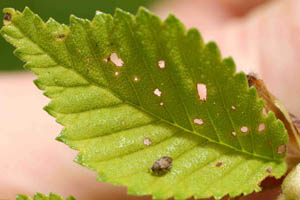Scouting Watch | |
|---|---|
| May 16, 2006 | |
|
Eastern tent caterpillars have matured, descended from their host trees, and are migrating across the ground searching for pupation sites. The larvae will pupate in protected sites and then emerge in late May to early June as one-inch-long, dark tan moths with white bands on their wings. After mating, they lay eggs in a mass encircling pencil-sized twigs of the host plant. They do not hatch until next spring. Honeylocust plant bugs and leafhoppers are present on honey locust throughout the state. The plant bug nymphs actively run up and down the stem when disturbed; the leafhopper nymphs sidle sideways to the other side of the leaflet or stem when disturbed. The leafhoppers cause no damage, but the plant bugs cause leaflet distortion, sometimes to the point of leaf drop. Dropped leaf areas will refoliate from lateral buds, but distorted leaflets that do not drop stay on the tree and reduce the aesthetic quality of the leaves through the summer. Acephate (Orthene), bifenthrin (Talstar), cyfluthrin (Tempo), or summer spray oil effectively controls these nymphs before severe damage is caused. Pine spittlebug has been reported in northeastern Illinois. The brown nymph grows to about -inch long and covers itself with froth (spittle) that is extruded from its anal area. These - to -inch globules of spittle are easily seen on the pine branches. If you pull the bark back where these nymphs have been feeding, you see a small, brown spot of necrosis in the wood. If there are many spittlebugs on a branch or tree, there can be enough necrosis to cause severe dieback of the tree. As long as the spittle masses are at least several inches apart on the tree, treatment is probably not needed. Very heavy infestations should be sprayed forcefully with carbaryl (Sevin) or other labeled insecticide. High-pressure spray is needed to wash off the spittle, allowing the insecticide to contact the insect. Elm flea weevil is numerous as adults eating pinhead-sized holes in leaves of Siberian elm and other European elm species in northeastern Illinois. This insect has been reported as far south as Kankakee. Control the flea weevil adults with a spray of acephate (Orthene), imidacloprid (Merit), bifenthrin (Talstar), or carbaryl (Sevin). The Orthene and Merit should also prevent larval mines from appearing later at the tips of the leaves.  Flatheaded appletree borer and roundheaded appletree borer attack young maples near the base, causing a helical tunnel under the bark that frequently kills the tree. They also attack crabapple, hawthorn, serviceberry, and related plants that are old and under stress. Imidacloprid should be applied at this time to the trunk and major branches. Peachtree borer is also susceptible to control with basal bark sprays of permethrin (Astro). It commonly attacks newly planted and aged purple leaf plum, flowering cherry, and other trees in the genus Prunus. Viburnum crown borers are also susceptible to control with permethrin (Astro) sprayed at the base of the shrub. Several species of clear-winged moth attack viburnums, with Viburnum opulus compacta typically being the most severely damaged. Damage is most likely to occur in young plants that have recently been planted.�� | |
| Author: | Phil Nixon Morton Arboretum |
